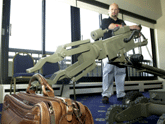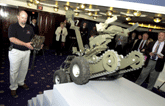The Defense Department has about 70 robots on explosives disposal duty in Iraq and Afghanistan, and the Joint Robotics Office in the Office of the Secretary is preparing to spend $18 million on 163 more robots, at the request of Central Command.Cliff Hudson, head of the joint office, said at a recent Washington briefing that DOD will 'down-select from five models to one or two for the field, based on operational assessments' by soldiers.Speaking at a demonstration by Northrop Grumman Corp.'s Remotec subsidiary, Hudson said the Defense Advanced Research Projects Agency fosters future robotics'for example, by its recent Grand Challenge race'whereas his office 'applies maturing technologies in the real world.'The office was set up in 1990, he said, because Congress saw 'the military services going off in different directions' for robotic development.The office has an annual budget of $35 million, which it invests in small robotic devices weighing around 400 pounds, midsized ones of more than 2,500 pounds and large, heavy ones such as the Marine Corps' Gladiator multi-purpose vehicle. The MPV can fire weapons envisioned in the Army's Future Combat Systems.The robotics office also buys what Hudson called 'smoke Humvees' that soldiers can dismount and send on to fog areas of a battlefield with a smoke generator.'It's a heavily tactical environment now,' Hudson said.The robots, commonly called UMGs for unmanned ground vehicles, 'give a critical standoff distance' for the soldier, Hudson said. 'Users are asking us for smaller and smaller robots that are easily transportable.'DOD also is about to begin a study of UMG interoperability with unmanned aerial vehicles, or UAVs, as well as with naval systems for sea-ground-air surveillance and reconnaissance.'The unmanned era is approaching very rapidly,' Hudson said. 'Until now, we've had point solutions. [Robots] are going to have to become semi-autonomous or autonomous and tightly integrated. We need to produce them in quantity.'Speed and weight have been the major complaints from soldiers who operate the robots remotely to disarm improvised explosives, said Mack Barber, president of Remotec.[IMGCAP(2)]By some estimates, Barber said, there are still 600,000 tons of unexploded ordnance, such as artillery shells, in Iraq. Terrorists are inventing new ways of concealing ordnance in garbage or animal carcasses, he said, detonating it with cell phones or garage door openers, and even placing secondary explosives to kill bomb technicians who approach a device.A robot sent to disrupt unexploded ordnance might spray it with a water jet, move it, or grip and pull it apart to break wires, Remotec manager Patrick A. Goode said. Company representatives demonstrated the 230-pound, khaki-colored Mini-Andros II climbing up and down stairs and grasping items in its 12-inch, 360-degree grippers. The battery-operated robot has four wheels, articulated tracks, three cameras, auto-iris light sensing and a 300-meter fiber-optic cable for direct operation.Usually, however, it is operated by radio. And operator fatigue is becoming a factor as more of the devices reach the battlefield.The Mini-Andros II, 'built from commercial, off-the-shelf parts,' can travel about four miles in two hours depending on the terrain, Goode said.Remotec sold about 1,000 of the Andros models last year, to DOD as well as to police and emergency response agencies. The funds mostly have come from Homeland Security and Justice department grants, he said.'We typically find that the bomb squad supports the SWAT team calls' for hazardous materials and other emergencies in jurisdictions that have robotic bomb-handlers, he said. The company maintains spare parts in Iraq and has found it must seal all openings tightly against sand.'We can diagnose some problems remotely,' Barber said, but future robots that will travel faster than 2 mph will 'need more intelligence to steer better.'Down the road, he predicted, military logistics will be simplified by robot convoys that can follow one human driver. And UAV-style sensors and advanced communications will begin to appear on UMG platforms.'UAV technology is a little ahead of UMG,' he said, particularly in communications. Robot teleoperation requires a line of sight, whereas UAV operators have sophisticated computers and satellite links.He commented on the managerial difficulty of 'getting seasoned engineers and [developers who grew up as] video gamers to work together. They will come into my office and say, 'I just can't work with' another developer. They don't agree on anything. But it's the only way to advance the technology.' Remotec, acquired by Northrop Grumman from Westinghouse Electric Co. in 1996, is a 30-year-old, 150-employee company in Oak Ridge, Tenn.
The Mini-Andros II, teleoperated by Royce Hollman, can grip small, delicate items as well as negotiate steep inclines.
J. Adam Fenster
The joint office was set up in 1990, Hudson said, 'because Congress could see the military services going off in different directions' for robotic development.








